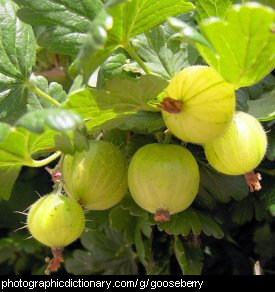Bis forBlackberry
Scientific name: rubus fruticosus
Blackberries are the fruit of a very thorny plant closely related to the raspberry. They spread quickly by sending roots under the ground that then sprout new plants. They can easily get unmanageable and are hard to keep under control because of the thorns. Today, you can buy thornless blackberries.
Blackberries are most often used to make jam.
Bis forBlackcurrant
Scientific name: ribes nigrum
Blackcurrents are a small berry related to redcurrants and gooseberries. They are used mainly for their juice, and made into drinks or cordials. Blackcurrents have a very, very high vitamin C content, with 100 grams of the fruit providing 3 times what you need each day.
Scientific name: vaccinium cyanococcus
Cis forCranberries
Scientific name: vaccinium oxycoccos
Gis forGooseberry
Scientific name: ribes uva-crispa
Scientific name: genus: morus
Mulberries are a small deciduous tree that likes temperate to tropical climates. Most varieties have black fruit that is red when it is underripe, but some have white fruit that is green when it isn't ripe yet.
Mulberries can be eaten fresh or used to make jam or pies. Black mulberries are the only plant that the silkworm eats.
Scientific name: rubus idaeobatus
Raspberries are the fruit of a very vigorous deciduous thorny bush related to blackberries, roses and strawberries. Raspberries can spread by sending out roots a long way under the ground that then sprout new plants. Raspberries can take over your backyard if you don't keep them pruned.
Raspberries can be eaten fresh, made into juice, or cooked into pies. Raspberries are very good for you.
Ris forRedcurrant
Scientific name: ribes rubrum
Redcurrants are a small berry related to gooseberries that are from Europe. They are quite sour and are only used for making jams and other cooked food. A paler, less sour type of redcurrant is called the whitecurrant.











